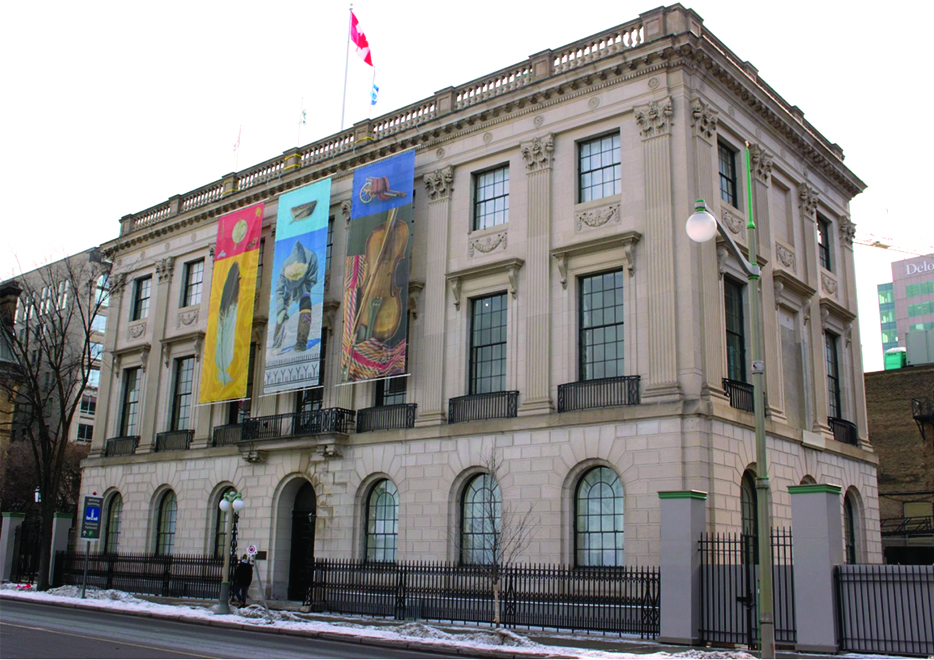Discussions underway to transform former U.S. embassy into Indigenous cultural centre
By Travis Poland
An interim working group has begun meeting to discuss the proposed national Indigenous cultural centre at the former U.S. embassy directly across from Parliament Hill.
Last June, Prime Minister Justin Trudeau announced that the building at 100 Wellington St., which has been vacant for 20 years, will become a “space for Indigenous peoples.”
Representatives from the Assembly of First Nations, the Metis National Council and Inuit Tapiriit Kanatami are now meeting regularly with federal government officials to recommend next steps to ensure the building becomes an inclusive space, Stephanie Palma, a spokesperson with Indigenous and Northern Affairs Canada, told Centretown News.
“Comprehensive consultations will be initiated in the near future to ensure that First Nations, Inuit and Metis voices shape the future use of the building and Indigenous Peoples are involved in leading the project,” Palma said.
Assembly of First Nations press secretary Jamie Monastyrski confirmed that the working group has begun talks to plan the cultural centre.
Erin Filliter with Inuit Tapiriit Kanatami added that the group is “working with Public Works alongside the Assembly of First Nations and Metis Nation to establish a vision for 100 Wellington.”
“Through this process, we look forward to ensuring the space is functional and reflective of Inuit in Canada as well as First Nations and Metis people,” said Filliter.
Chief Kirby Whiteduck from the Algonquins of Pikwakanagan First Nation, located about two hours west of Ottawa, said he hopes to meet with the Assembly of First Nations to discuss the building’s future.
“It would be nice to see something concrete happen there and have some of our involvement,” Whiteduck said. “Given that it is on unceded Algonquin territory, we hope for the involvement and input from Algonquin brothers and sisters north of the Ottawa River.”
The Assembly of First Nation’s general assembly met last July and passed a motion, put forward by Whiteduck, directing the Assembly to determine the most effective use for the building and to put protocols in place ensuring the Algonquin Nation is engaged in the consultation process.
The government’s plan for 100 Wellington St., however, is not without its critics.
The Royal Architectural Institute of Canada’s Indigenous Task Force — which is composed of about 30 mostly Indigenous architects, architectural students, interns and academics — released a statement last June following the Prime Minister’s announcement, arguing that the former embassy “is not a culturally appropriate space for an Indigenous Centre.”
“Indigenous people always get the hand-me-downs, the buildings, and land that settlers no longer have a use for,” the statement reads.
The architectural institute said it would be willing to meet with the government during the consultation process, but have yet to be contacted, said Bruce Lorimer, who served as the institute’s interim executive director until early March.
Under the government of former prime minister Jean Chretien, 100 Wellington St. was slated to become a national portrait gallery, but that plan was quashed by the Conservative government of Stephen Harper.
In 2016, Public Services and Procurement Canada conducted a survey to explore potential uses for the building. The survey listed six potential uses, and after 7,000 public responses were received, the top three choices included a gallery, a “Canada House” showcasing the best of the provinces and territories, and an Indigenous cultural centre.
The Beaux-Arts heritage structure was completed in 1932 and designed by American architect Cass Gilbert, who also designed the U.S. Supreme Court building in Washington, D.C.
The redevelopment of the old embassy is part of the long-term vision and plan for the Parliamentary precinct, which includes fully restoring and modernizing older buildings both inside and out, and ensuring that the buildings meet current safety standards.

